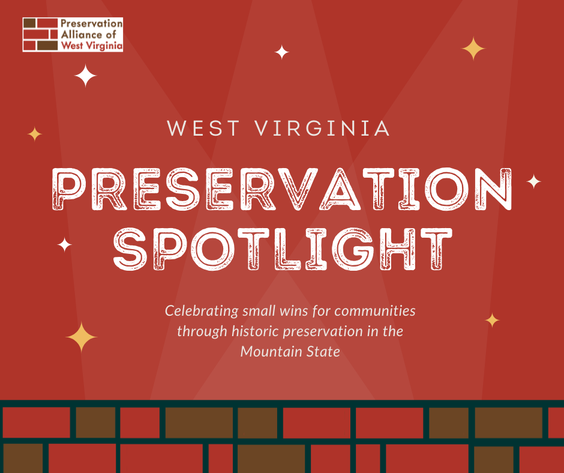|
West Virginians are invited to celebrate their historic preservation success stories through the Preservation Alliance of West Virginia’s new West Virginia Preservation Spotlight series. Submitting a Preservation Spotlight story helps shine a light on the small preservation successes that can add up to significant positive change in a community. Whether it’s a homeowner restoring a historic feature of their house or a business moving into a building on historic Main Street, PAWV wants to hear about preservation “wins” both big and small.
Spotlight stories should involve a West Virginia property listed on the National Register of Historic Places or as a contributing structure to a National Historic District. If you believe your story is relevant despite not meeting this specification (perhaps an event or advocacy success), please email to check with a member of our staff at [email protected]. Submitted Preservation Spotlight stories may be featured on PAWV’s website and social media channels to celebrate the positive steps everyday West Virginians are making towards historic preservation in their communities. PAWV is accepting submissions through a Google form here. A Word document submission form is available for download below.
2 Comments
The Preservation Alliance of West Virginia is still accepting applications for new sites to be added to the West Virginia Historic Theatre Trail. Theater owners, interested community organizations, and others can apply to add a theater to the Trail by submitting an application form to [email protected] by December 7, 2015, at 5:00pm. Download the application form at the WV Historic Theatre Trail website:
https://wvhistorictheaters.wordpress.com/ Preservation Alliance of West Virginia introduces the Buildings At Risk Register (BARR). This new program will allow PAWV to better examine preservation needs statewide. Too often buildings are razed because threats go unreported, and PAWV is striving to minimize the loss of West Virginia’s heritage. There is a need to create a preservation network to prevent such easily avoidable losses in the future. PAWV can utilize its full arsenal – assistance with identifying and applying for grant funding; preservation skill seminars; and local, state, and national publicity to assist in re-using historic sites.
This goal of PAWV can be accomplished with three easy steps: See. Speak. Save. If you see a property at risk, speak to PAWV, and we will do our best to work with the community to save it. How does the Buildings At Risk Register work? When you see an at risk property, you should contact PAWV. This can be done by submitting an online form: https://docs.google.com/forms/d/1eLl_Md038tM91rOyL-Z-xL8gmywwCWGC9Q0Ymoz1FNY/viewform. Ideally, you will provide the address of the property and the reason(s) why this property should be considered at risk. Furthermore, any additional information such as former use, last known date occupied, current condition, owner etc. is greatly appreciated. As PAWV collects submissions, we can create a Buildings At Risk Register. Each submission will be reviewed by a PAWV committee and determined eligible for this register. Some cases may be eligible for PAWV’s Endangered Properties List, which requires significant community engagement, but gains more PAWV support in return. For more information, please refer to the BARR vs. Endangered Properties List guide: https://docs.google.com/document/d/1lkKwpUhiAcSa7_nporaim-4vLdDH3Wd7FtcShYx3w1o/edit?usp=sharing. The Waldomore is an excellent example of preservation which has become Clarksburg’s landmark example of showcasing the county’s image through architecture and public use. In addition, the Robinson Grand Theater, The Waldo Hotel, The Gore Hotel, Goff Building and the Olymbec/Chase Buildings are outstanding examples of current and future rehabilitation of some of Harrison County’s major inner city buildings. Private homes on “Quality Hill” are excellent examples of that designated historic district.
Shinnston, Salem, West Milford, Lumberport, among other smaller communities, are examples of residents and business owners taking pride in their local heritage. HCHS feels that it takes a community to preserve its history. The Historical Society will partner with the Preservation Alliance staff to discuss economic incentives, developing community awareness and pride. Collaboration with local government, along with public and private involvement in preservation will be related to heritage tourism. The Harrison County Historical Society’s historic house museum, the Stealey, Goff Vance House built in 1807, is a prime example of a historic building that can stand out proudly with further development, renewed use and community involvement. Discussion, collaboration and promotion can lead to increased economic value. Preservation Alliance and the Historical Society will offer examples of preservation efforts, building re-purposing, and heritage tourism outcomes. Local business and property owners are encouraged to bring questions, ideas and thoughts on preservation, economic development and heritage tourism for a discussion to follow the presentation. The Historical Society will continue programs involving both architectural and archival preservation in 2015. The discussion on community development through preservation and heritage tourism will take place at The Waldomore in Clarksburg, January 27th, 5:30 pm. Coffee and refreshments will be available. For more information or questions contact Carol at [email protected]. For a list of presenters see the web site harrisoncowvhistoricalsociety.org |
News and NotesCategories
All
Archives
May 2024
Subscribe to our mailing list to receive e-news updates on historic preservation news and events in West Virginia.
|
Get Involved |
Programs |
Contact UsPreservation Alliance of West Virginia
421 Davis Avenue, #4 | Elkins, WV 26241 Email: [email protected] Phone: 304-345-6005 |
Organizational Partners:
© COPYRIGHT 2022 - PRESERVATION ALLIANCE OF WEST VIRGINIA. ALL RIGHTS RESERVED.



 RSS Feed
RSS Feed



